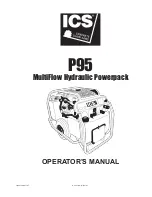
7
router
.
W
hen using your router hold it firmly with
both
hands.
Before starting the router, unplug it and make sure the
cutter is securely tightened in collet nut and that depth of
cut is properly set.
Plug router into power supply, turn it on and let motor
build to its full speed, then gradually plunge or feed cutter
into workpiece. Do not let the cutter contact workpiece
before turning on router and allowing it to develop full
speed.
Remain alert and watch what you are doing. Do not operate
router when fatigued or under the influence of drugs,
alcohol or any medication.
ROUTING GROOVES (FIG. 13)
When routing across the face of boards, set router at
desired depth of cut, place the edge of router base against
workpiece and turn on the router. Slowly feed the cutter
into the workpiece along desired line of cut.
WARNING:
If desired depth of cut is greater than can be
safely cut in one pass, make cuts in two or more
passes.
When routing straight cuts across
timber
, clamp a straight
edge to the workpiece to use as a guide. Position the
straight
edge parallel to the line of cut and offset the
distance between the cutting edge of the cutter and the
edge of the router base. Hold the route base against
the
straight
edge and rout
e
the groove.
When routing a groove wider than the diameter of the
cutter, clamp a straight
edge on both sides of the cut-
lines. Position both guides parallel to the desired line of
cut and spaced equal distances from the desired edges
of the groove. Rout
e
along one guide; then, reverse
direction and rout
e
along the other guide. Clean out any
remaining waste in the center of the groove freehand.
FITTING AND ADJUSTING THE PARALLEL
GUIDE (FIG. 14)
■
Insert the parallel guide (20) into the hole of the Router
base (16).
■
Draw a cutting line on the work-piece (26).
■
Lower the router body until the cutter is in contact
with the work-piece.
OPERATION
■
Postion the router on the cutting line. The outer cutting
edge of the cutter must coincide with the cutting line.
■
Without moving the router push the
g
uide to the edge
of the workpiece before tightening the lock knob
(6)
.
ROUTING BY FREEHAND (FIG. 15)
When used freehand, your plunge router becomes a
flexible and versatile tool. This flexibility makes it pos-
sible to easily rout
e
signs, relief sculptures, etc. There are
two basic techniques for freehand routing:
■
Routing letters, grooves and patterns into wood.
■
Routing out the background, leaving the letters or
pattern raised above the surface.
When freehand routing, we suggest the
following:
■
Draw or layout the pattern on workpiece.
■
Choose the appropriate cutter.
NOTE: A core box or V-groove bit is often used for
routing letters and engraving objects. Straight bits
and ball mills are often used to make relief carvings.
Veining bits are used to carve small, intricate details.
■
Rout
e
the pattern in two or more passes. Make the
first pass at 25% of the desired depth of cut. This
process will provide better control as well as being a
guide for the next pass.
■
Do not rout
e
deeper than 3.2 mm per pass
or cut.
Follow these directions when routing by
freehand:
■
Choose the appropriate cutter, set desired depth of
cut, carefully check set-up, and secure workpiece.
■
Make a test cut in a scrap piece of wood from the
same workpiece if possible.
■
Unlock plunge lock lever to raise cutter from any preset
depth of cut. This also permits raising cutter inside
router base.
■
Place router on workpiece inside pattern to be
routed.
■
Grasp handles securely and press the switch to start
your router.

































